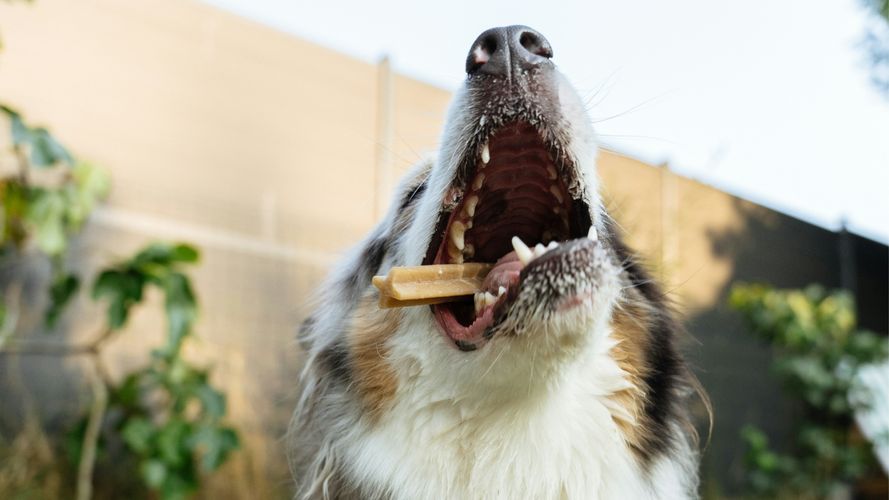Dog Dental Health: Fresh Breath and a Healthier Life
17th Sep 2025
There’s nothing better than a happy, tail-wagging welcome home from your pup — but if their breath makes you want to turn away, it could be more than just “doggy breath.” Around 80% of dogs over three years old show signs of dental disease, and left untreated, it can affect more than just their mouth.
Let’s take a closer look at what dental disease really is, the signs to watch for, and the best ways to keep your dog’s teeth (and breath) in top shape.
What Is Dental Disease in Dogs?
Dental disease usually starts with plaque — a sticky film of bacteria that forms on teeth. If it isn’t removed, plaque hardens into tartar (calculus), irritating gums and harboring even more bacteria. Over time, this leads to two main problems:
- Gingivitis – Inflammation of the gums, caused by plaque bacteria along the gumline. It’s the earliest (and reversible) stage of dental disease.
- Periodontitis – When gingivitis isn’t treated, bacteria spread below the gumline. This damages the tissue and bone that support the teeth, leading to loose or lost teeth and painful infection.
Dental disease doesn’t stop at the mouth. Chronic inflammation and bacteria can travel through the bloodstream, putting extra strain on the heart, kidneys, and liver.
Signs Your Dog Might Have Dental Problems
Dogs are good at hiding discomfort, so you’ll need to be proactive. Some common warning signs include:
- Bad breath (fishy or foul smell)
- Red, swollen gums
- Yellow or brown buildup on teeth
- Dropping food while eating or chewing on one side
- Excessive drooling
- Pawing at the mouth
- Loose or missing teeth
⚠️ Many dogs will still eat normally despite painful dental disease, so don’t assume “they’re fine because they’re eating.”
How Vets Diagnose and Treat Dental Disease
If you notice signs of dental disease, the first step is a vet checkup. Your vet can:
- Grade the severity of dental disease
- Take dental X-rays if needed
- Recommend a scale and polish under anesthesia to thoroughly clean above and below the gumline
While a professional dental cleaning may sound daunting, it’s the only way to fully remove tartar and bacteria once they’ve built up. Anesthesia is essential to allow safe, thorough cleaning and examination. Avoid “anesthesia-free dentals,” as they only clean the surface and miss the disease below the gums.
Everyday Ways to Keep Your Dog’s Teeth Healthy
The good news? With the right prevention routine, you can keep dental disease under control — and even add 2–4 years to your dog’s life.
- The gold standard of dental care
- Use a dog-specific toothpaste (never human toothpaste)
- Start slowly, with short sessions, and reward with praise or treats
- Aim for daily brushing, but a few times a week is still better than none
2. Dental Diets
Specially formulated kibble can help reduce plaque as your dog chews.
For dogs without existing disease, oral care diets (non-prescription) can provide extra prevention.
Chewing scrapes plaque off teeth, but only if your dog doesn’t gulp them down! Some recommended brands include:
Follow packet guidelines for size and frequency, and remember to count treats toward daily calories.
4. Water Additives & Supplements
Easy to use and good for freshening breath, though not a replacement for brushing. Popular options include:
Change water daily and refresh with each refill.
5. Chew Toys
Durable dental toys encourage natural chewing, which helps clean teeth. Always choose size-appropriate toys to avoid damage. Shop our chew & dental toy range here.
⚠️ What about bones? While raw bones may scrape teeth, they come with serious risks like tooth fractures, choking, and bacterial contamination. Safer dental chews and toys are better alternatives.
Dental care isn’t just about fresh breath — it’s about giving your dog a longer, healthier life. By combining at-home prevention (like toothbrushing, chews, and diets) with regular veterinary checks, you can help your pup avoid pain and serious health issues down the track.
If you’re unsure about your dog’s dental health or need help getting started, ask your vet for a dental exam or advice on the best prevention plan for your dog.

